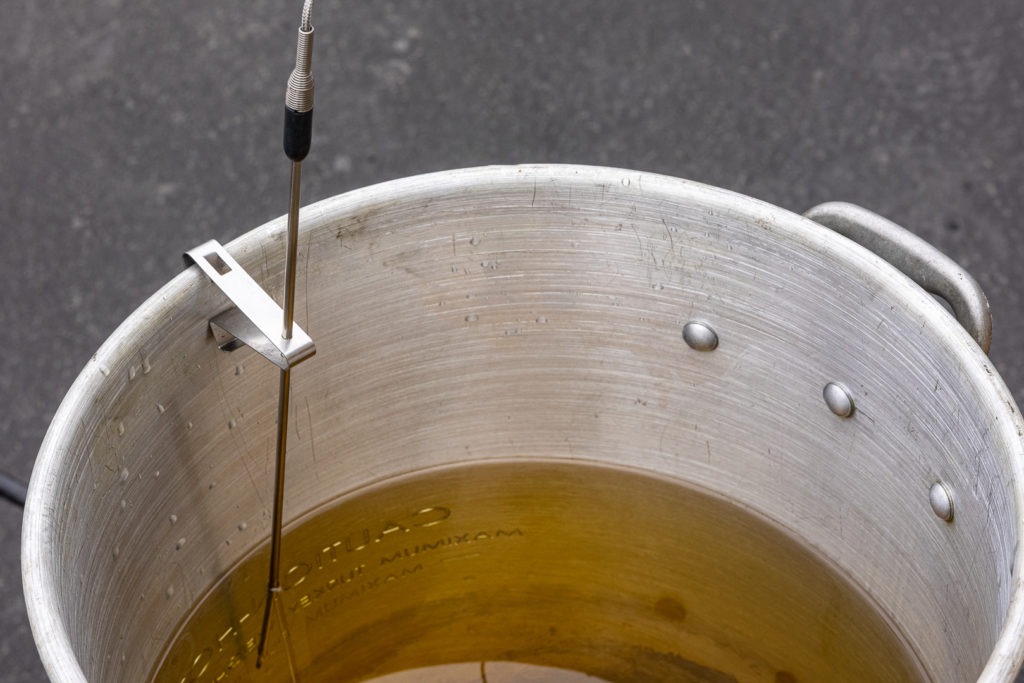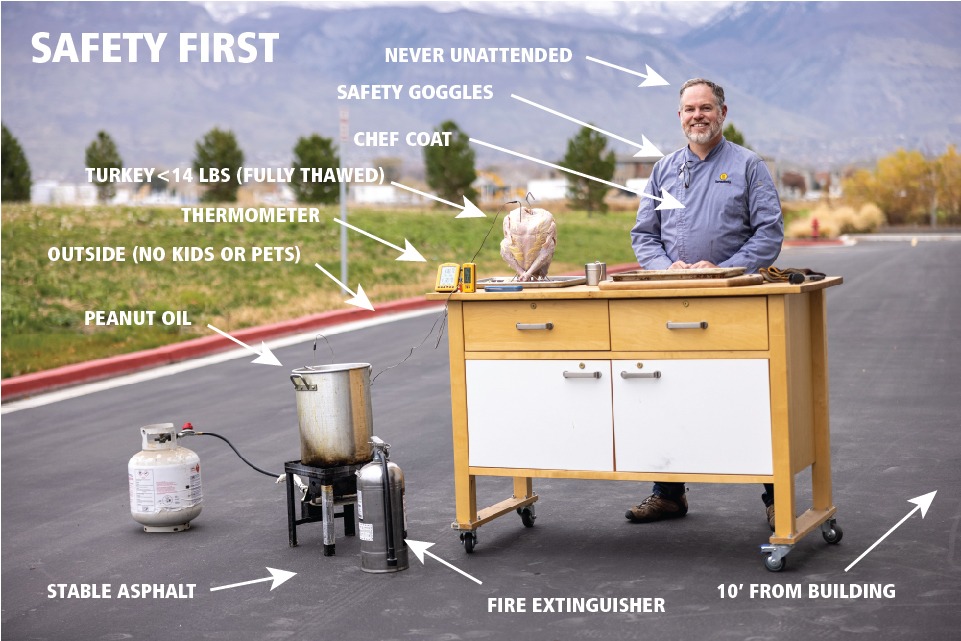Are you in the mood to try something different this year with your Thanksgiving turkey? Why not try deep frying it this year? Some say a fried turkey is the juiciest, most flavorful, crispy-on-the-outside, delicious bit of poultry ever to cross their lips. This project is packed with thermal critical control points that will determine the safety of the cook and the quality of the finished product—and we have all the tips you need.
We’ll be using the ThermoWorks® Smoke X2™ 2-Channel Alarm Thermometer with an additional 12″ Pro-Series® High Temp Probe so we can measure both the turkey meat and the critical oil temperature on the same device.
Fried turkey has developed a cult following in recent years, with enthusiasts claiming it’s far superior to roasted turkey. But does deep-frying really make that big of a difference in flavor and texture? As a food blogger always looking to try new cooking methods, I was curious to find out.
So I did some research on fried turkeys, surveyed people who have tried both fried and roasted, and even fried a turkey myself to get the full experience. Here’s a comprehensive look at what fried turkey tastes like compared to roasted.
Flavor
Hands down, the number one thing people say about fried turkey is that it has way more flavor. The seasoning and spices seem to penetrate the meat better, allowing you to taste them throughout every bite rather than just on the surface.
Part of this comes from brining or aggressively seasoning the turkey before frying. The high heat almost caramelizes the seasoning into the meat, taking the flavor to new heights
Even without a rub, fried turkey still has more pronounced turkey flavor. The Maillard reaction occurs throughout the entire bird as it cooks, enhancing the savory roasted meatiness.
So if you’re looking to really savor that turkey flavor, frying is the way to go. Roasting seems to mute the flavor a bit more
Texture
Texture is another area where fried turkey shines. The high heat crisps up the skin magnificently all over the bird, even on the undersides. No more flabby skin!
The meat itself also comes out incredibly moist and juicy. The fast cooking time means less moisture is lost, keeping the meat succulent.
By contrast, roasted turkey often suffers from dry white meat. Since the breast cooks faster, it ends up overcooking while the thighs and legs finish. Frying cooks the entire turkey at once, preventing uneven moisture loss.
If you prize juicy, crispy turkey texture, frying is sure to satisfy. Roasting can dry out parts of the bird.
Convenience
One of the biggest perks of fried turkey is how fast it cooks. A 12-14 lb bird takes only about 45 minutes to an hour start to finish.
Compare that to roasting, which takes at least 2-3 hours for a bird that size. Plus roasting ties up your oven for sides and pies.
Frying also gives you incredibly moist dark meat every time. No need to meticulously monitor to prevent drying out.
So if oven space and time is limited, fried turkey is a lifesaver. You can cook it outdoors quickly while the oven bakes other dishes.
Fear Factor
The biggest barrier for many home cooks is that frying seems scary or dangerous. Having a huge pot of bubbling hot oil in your backyard can seem like an accident waiting to happen.
But with proper precautions, frying turkey is actually quite safe. The key is using a dedicated turkey fryer, propane burner, thermometer, and thick heavy pot designed specifically for frying.
Don’t try to rig up your own setup. With the right gear, it’s no more dangerous than average backyard grilling. Just be smart and exercise caution.
Cost
Frying does require special equipment that roasting doesn’t. You’ll need a large propane burner, pot, thermometer, turkey rack, propane, and several gallons of oil.
All in you’re looking at $150-300 upfront. The oil can be reused several times, but eventually you’ll need to replace it.
Roasting just needs a roasting pan and oven you likely already own. So there’s more startup cost with frying.
Taste Test Results
I tried frying a turkey myself using a rub recipe from Tasty. Even as a roasted turkey lover, I was blown away by the results.
The white and dark meat were perfectly moist, and the skin wonderfully crispy. The spicy rub permeated the meat with tons of flavor. It was hands down the best turkey I’ve ever made.
In an informal poll of friends who had tried both, the overwhelming consensus was that fried is far tastier. The extra flavor, moisture, and texture really shine.
The Verdict
Based on my research and tasting, fried turkey definitely seems to live up to the hype. The flavor and texture are markedly better than roasted.
If you’re up for the extra effort, equipment, and oil required, frying your Thanksgiving or holiday bird is pretty hard to beat. You’ll get incredibly juicy, crispy, flavor packed turkey every time.
That said, roasting still has its merits too. It’s cheaper, easier, and better for those nervous about frying. Not everyone has the space or comfort level for it.
But if you want your best turkey ever, and are willing to fry safely, I highly recommend giving it a shot. Your taste buds will thank you!
Tips for Frying Turkey Perfectly
If you’re ready to try deep frying a turkey, follow these tips for safety and maximum flavor:
-
Use a turkey fryer kit designed for frying. Don’t rig your own setup.
-
Fry outside away from homes, garages, wooden decks, etc.
-
Thaw turkey completely and pat dry. Any moisture can cause hot oil to bubble furiously.
-
Use peanut, canola, or vegetable oil with high smoke points.
-
Slowly lower turkey into oil preheated to 325-350°F.
-
Cook 3-4 minutes per pound. Monitor oil temp.
-
Use an oil thermometer like Thermapen to monitor temperature.
-
Let turkey rest 20 min before carving for juicy meat.
-
Reuse oil 2-3 times then replace to avoid tasting burnt.
The Bottom Line
When prepared safely, deep fried turkey is an extremely juicy, flavorful, and crunchy alternative to roasting. The sear from hot oil seals in moisture and allows seasoning to penetrate deeply. While roasting certainly has its place, fried turkey is hard to top for texture and taste. If you’re up for some backyard cooking adventure, give frying a try this holiday season!
:max_bytes(150000):strip_icc()/215412-simple-deep-fried-turkey-vat-01-4x3-1-fc3078f38cd542a5a223d9c53ef25596.jpg)
What Type of Oil?
An oil with mild flavor and a high smoke point is needed for this deep-frying project, and peanut oil fits the bill perfectly. Its flavor is very neutral and has a smoke point of about 450°F (232°C).
If you or any guests have a peanut allergy, corn, safflower, and sunflower oil are options with high smoke points as well.

Why fry a turkey?
Deep frying your holiday bird will take less time than roasting does. Most turkeys take about 3 minutes per pound to fry. For example, a 14-pound turkey will take about 42 minutes to cook. While your turkey is cooking outside, the oven will be available for baking rolls, pies, and side dishes.
Frying a whole turkey in hot oil can be dangerous, and caution must be observed. Thousands of fires and injuries occur every year due to turkey fryer fires. Hot oil is highly combustible, and the pot of hot oil will be sitting directly over an open flame. Follow these important tips to ensure the safety of your cook.
- Keep a dry-powder, multipurpose fire extinguisher handy at all times. Never use water to put out a grease fire, it will cause the hot oil to spatter, thereby spreading the fire rapidly.
- Take it outside. Set up the turkey fryer more than 10 feet away from your home, covered patio, roof overhangs, and any other building.
- Set up the burner on stable ground, concrete, or asphalt. Not a wood deck.
- Keep fryer away from children and pets.
- Never leave the setup unattended. Stay within a 10-foot perimeter of the hot oil at all times.
- Don’t drink and fry. The process requires full, focused attention.
- Use a thermometer. Temperature control is crucial. Do not allow the oil to exceed 350°F (177°C).
- Thaw turkey completely. The dramatic temperature difference between a frozen turkey and the hot oil will cause furious bubbling and spillage. If oil spills over the pot it can start a fire, cause an explosion, and result in injury and property damage.
- Pat the turkey completely dry with paper towels. Water on the surface will splatter when lowering the turkey. Splatters cause grease fires.
- Turn off the gas completely when filling the pot with oil, lowering the turkey into the hot oil, lifting the turkey out of the oil, or when removing the pot full of oil from the burner.
- Wear an apron or chef jacket, safety goggles, and use heavy duty elbow-length gloves.

How to fry a turkey SAFELY
FAQ
How does fried turkey taste?
In effect we had a taste panel where our twenty guests got to try both a roasted and fried turkey. There was no question that the fried turkey tasted better. It was more savory and had a richer flavor. It gave new meaning to the saying: “you can fry anything and it will taste better”.
Is deep-fried turkey really that good?
Deep-frying a turkey is a bit of an undertaking, but the result is a juicy bird with potato-chip-crisp skin. Daniel joined the Serious Eats culinary team in 2014 and writes recipes, equipment reviews, articles on cooking techniques.
What does turkey taste similar to?
Turkey meat is a white meat that is mild in flavor. It has a slightly sweet taste that is similar to chicken, but it is slightly leaner and has a slightly different texture. Turkey meat is a good source of protein and is low in fat.
Why do people like fried turkey?
Deep frying turkeys has become a popular cooking method, particularly during holidays like Thanksgiving, for several reasons: Flavor and Texture: Deep frying produces a crispy exterior and juicy interior, which many people find appealing compared to traditional roasting.
